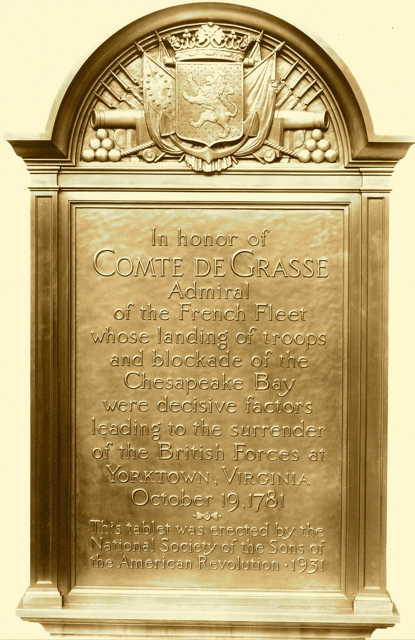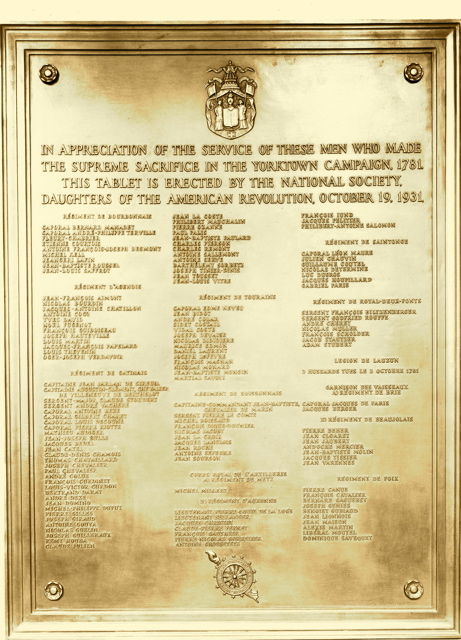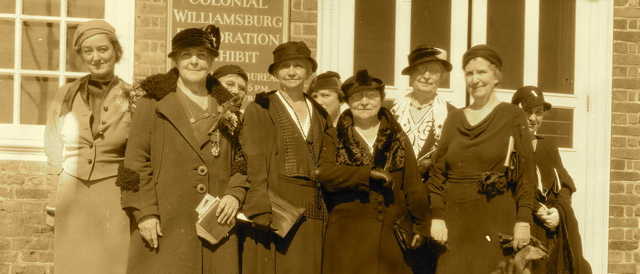Chapter History
Chapter 5
The Sesquicentennial
The 150th anniversary of the Surrender was approaching, and the event was to be one of the most notable affairs in modern Yorktown history.
Comte de Grasse Chapter, Mrs. Chenoweth, and the Custom House were in the thick of the excitement.
Virginia Governor Harry F. Byrd had appointed Mrs. Chenoweth to the commission, and her name appears on all official stationery. She went to work immediately in her customary fashion. Her priority: recognizing the Admiral Comte de Grasse who she affectionately referred to as "the forgotten man."
In correspondence with the Rev. William A. R. Goodwin of the Williamsburg Restoration, she inquired about the possibility of the SAR placing a tablet at Yorktown to the memory of Admiral de Grasse. She wanted it to read: "Through the courtesy of the Comte de Grasse Chapter of the Daughters of the American Revolution which restored this Custom House this tablet has been placed here in memory of Comte de Grasse."
 Mountains of correspondence followed. In the end, Tiffany of New York made the tablet (left). Not all of Mrs. Chenoweth's ideas were incorporated in the finished tablet; in fact, four versions of the tablet were made and sent to Mrs. Chenoweth before she was satisfied with the final product. The final design was put on a wooden template and shipped to Mrs. Chenoweth, who placed it on the wall to see the effect. She was pleased.
Mountains of correspondence followed. In the end, Tiffany of New York made the tablet (left). Not all of Mrs. Chenoweth's ideas were incorporated in the finished tablet; in fact, four versions of the tablet were made and sent to Mrs. Chenoweth before she was satisfied with the final product. The final design was put on a wooden template and shipped to Mrs. Chenoweth, who placed it on the wall to see the effect. She was pleased.
Not one to be satisfied with mediocrity, Mrs. Chenoweth was not above going to the highest authority to obtain what she wanted. In 1930, she wrote to the Secretary of the Navy, informing him of the plans that were then being made for the celebration in 1931. In order to arouse national enthusiasm for the 150th anniversary the next year, she asked that a "number of battleships and naval vessels be sent into historic York River to pay homage to this great event."
She also wrote letters to the White House, requesting that Mrs. Roosevelt consider coming to Yorktown to participate in one of the later October 19th celebrations. Mrs. Roosevelt did accept but later had to decline because of pressing engagements.
 During the 1931 celebration, many famous people visited Yorktown and the Custom House, including President Herbert Hoover. What a wonderful opportunity to showcase the newly renovated building. After working so hard to have the Custom House restored, Mrs. Chenoweth took great pains to see that it survived the excitement of the Sesquicentennial. The property was deemed so valuable that a military guard was posted night and day during the festivities.
During the 1931 celebration, many famous people visited Yorktown and the Custom House, including President Herbert Hoover. What a wonderful opportunity to showcase the newly renovated building. After working so hard to have the Custom House restored, Mrs. Chenoweth took great pains to see that it survived the excitement of the Sesquicentennial. The property was deemed so valuable that a military guard was posted night and day during the festivities.
Just the year before, President Hoover established the Colonial National Monument, to include 2,500 acres of the Yorktown Battlefields and another 1,500 acres at Jamestown. The Daughters' victory came just in time for the Sesquicentennial celebration of the victory at Yorktown.
 A contingent of almost 300 DAR ladies chartered a ship to take them from Washington, D.C. to Yorktown, where they took part in ceremonies on the battlefield they had campaigned so long to save. Mrs. Morris' campaign was finally a success.
A contingent of almost 300 DAR ladies chartered a ship to take them from Washington, D.C. to Yorktown, where they took part in ceremonies on the battlefield they had campaigned so long to save. Mrs. Morris' campaign was finally a success.
Mrs. Morris (left), by then national chairman of the DAR Yorktown Celebration Committee, was there when the new Colonial National Monument was declared on October 16. And she heard Horace Albright, director of the National Park Service, tell assembled dignitaries that "had it not been, for the years of discussion and persuasion and other determined efforts by the DAR this battlefield of Yorktown would not now be authorized to be part of the NPS, to be forever preserved as nearly as possible as its terrain appeared in 1781."
 Mrs. Chenoweth also arranged for the dedication of the Gallatin tablet in honor of Barron Gaspard de Gallatin, and other tablets in honor of Major William Gooch and Governor Thomas Nelson, Jr.
Mrs. Chenoweth also arranged for the dedication of the Gallatin tablet in honor of Barron Gaspard de Gallatin, and other tablets in honor of Major William Gooch and Governor Thomas Nelson, Jr.
She was also part of the Group of NSDAR members who placed a marker at the Yorktown Monument in memory of the American and French soldiers who had died during the campaign in 1871 (right).
Next Chapter : Chapter 6 The Museum
